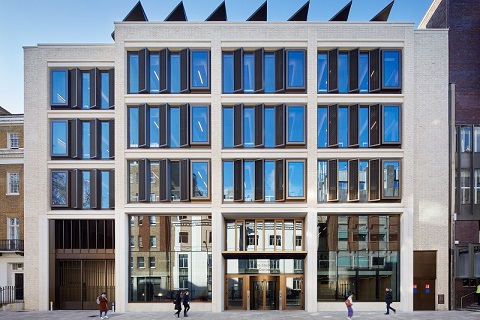Exemplary environmental performance in the heart of Bloomsbury
Project Details
- Certificate Number: BREEAM-0052-4546
- Stage: Interim
- Scheme & Version: New Construction 2011
- Location: London, UK
- Score & Rating: 85.2%
- BREEAM Awards 2018 – Highly Commended
Project Team
- Client/ Developer: UCL
- Assessor Company: Southfacing Services Ltd
- Contractor: Mace
- Project Manager: Arcadis
- Architect: Nicholas Hare Architects
- Building Services: BDP
- Sustainability Consultant: Expedition
Green Strategy
UCL has set a clear vision of ambitious targets for delivering sustainability across its estate – the New Student Centre embodies these principles, setting the benchmark for future projects. Our ‘Transforming UCL’ programme represents a series of exciting new build projects, as well as challenging refurbishments, which will all have a role to play in meeting these targets. BREEAM is a vital measure in this approach.
The UCL Student Centre will be a demonstrator of environmental excellence for all future UCL development projects – and, we hope, for other higher education buildings around the UK and beyond. The high quality design is both sympathetic to the sensitive Bloomsbury conservation area, whilst also pushing the boundaries of sustainable development on a constrained urban site. The building will help to alleviate pressures on existing study space, whilst also enhancing the student experience by being responsive to future change, with flexible spaces and integrated technology.
The project team has demonstrated a consistent and driven commitment to UCL’s core objectives – including the pursuit of an Outstanding rating – all to ensure this scheme is seen as a true exemplar within the higher education sector. UCL has committed the resource and expertise required for such aims, with no less than three sustainability champions working seamlessly across UCL, the design team and the contractor. This rigour has resulted in coordinated, detailed scrutiny of the requirements of individual credits, always with an eye to maintaining or increasing the score whilst providing demonstrable value benefits.
“BREEAM provides a robust and well-understood framework for the implementation of sustainability on the UCL estate in support of our 20-year development strategy, ‘UCL 2034’. It also complements the university’s Sustainability Strategy, as well as our ambitious Carbon Management Plan and Sustainable Building Standard. This is reflected in support for achieving the highest possible ratings from UCL’s senior management team.” Anthony Smith, Vice-Provost (Education & Student Affairs)
Achievements
- ‘Passive first’ approach to design based on highly efficient building fabric which helps to regulate temperature and minimize energy use. EPC A rating confirmed.
- 35% reduction in building carbon emissions compared to Building Regulations requirements (Part L 2013)
- 400m2 of solar PV panels on the roof provide clean, renewable energy
- Ground source borehole system provides both heating and cooling
- Natural ventilation strategy includes high levels of thermal mass coupled with night purge during the summer season.
- Highly efficient sanitary fittings will reduce water consumption by 55% over baseline performance
- Healthy and productive study spaces, optimising daylight, indoor air quality and providing a comfortable internal climate
- Highly durable materials will help to minimise resource use associated with maintenance and repairs
- Biodiversity enhancements include planting in the adjacent Japanese Garden and a green roof which will also have a positive influence on the microclimate
“The Student Centre is the centrepiece of our £1.25 billion ‘Transforming UCL’ programme and represents a clear commitment to exemplary sustainable design.”Ben Stubbs, Senior Sustainability Manager, UCL

 The building’s energy strategy has been aligned with BREEAM Ene 01, resulting in a detailed focus on the following:
The building’s energy strategy has been aligned with BREEAM Ene 01, resulting in a detailed focus on the following:– ‘Passive first’ approach to design based on highly efficient building fabric and use of thermal mass which helps to regulate temperature and minimize energy use, and corresponding levels of detailing.
– In typical winter and summer conditions displacement ventilation fed from a modest raised floor zone will provide fresh air which is extracted through the atrium at high level. Supply air is tempered by either free cooling from the GSHP or by free heat recovered from the extracted air (MVHR) resulting in reducing energy bills for UCL and improving the environment for the Students.
– The building is projected to achieve a 35% reduction in building carbon emissions against Building Regulations requirements (Part L 2013) and 40% improvement on Part L 2010.
– Design stage modelling indicates a minimum 20% reduction in building CO2 emissions, achieving all five credits for low and zero carbon technologies (Ene 04) – this is based on:
1) ’Free’ cooling will be provided using an open loop ground source borehole system connected to cooling pipes embedded in the underside of the floor slabs and cooling coils in the AHUs. Heat pumps use the borehole for low grade heat regeneration.
2) Connection to UCL’s District Heat Network.
3) The 50KWP PV array (around 400m2) is UCL’s largest installation to date, extending to the roof of the neighbouring Bloomsbury Theatre.
 Another area of particular importance to UCL has been optimising the working environment in order to improve health and productivity:
Another area of particular importance to UCL has been optimising the working environment in order to improve health and productivity:– A mixed mode strategy with automatic window actuators will naturally ventilate the building in the spring and autumn preventing overheating while eliminating the need for mechanical ventilation and reducing the requirement for active cooling (Hea 02).
– A central atrium will help to draw heat up and out of the building in the summer. In the winter this waste heat will be captured and used by the AHUs to pre-heat incoming fresh air.
– The provision of a detailed indoor air quality plan helped to steer design decisions in an area of sensitivity given the proximity of particularly congested roads (Hea 02). This resulted in the selection of self-finished natural materials.
– Visual comfort has been prioritised using daylight modelling to optimise facades and achieve maximum penetration of natural daylight (Hea 01), whilst reducing the need for artificial light. This includes tall windows extending up to soffit-level, clerestory windows and a glazed atrium. The glazing design is responsive to orientation to minimise unwanted solar gains, creating comfortable spaces to study.
 The project has carefully considered opportunities for improving biodiversity on this significantly constrained urban site, particularly at roof level. There areas of biodiverse roof that assist with rainwater attenuation are combined with external amenity space for users, as well as space for PVs, and rooflights. Enhancements will also have a positive influence on the microclimate and provide additional ecological value within the Bloomsbury Conservation Area.
The project has carefully considered opportunities for improving biodiversity on this significantly constrained urban site, particularly at roof level. There areas of biodiverse roof that assist with rainwater attenuation are combined with external amenity space for users, as well as space for PVs, and rooflights. Enhancements will also have a positive influence on the microclimate and provide additional ecological value within the Bloomsbury Conservation Area.
 UCL’s high expectations were clearly embedded and communicated in tender documentation, and remained under constant review by the project management team, as well as the principal contractor’s Sustainability Manager (Man 02).
UCL’s high expectations were clearly embedded and communicated in tender documentation, and remained under constant review by the project management team, as well as the principal contractor’s Sustainability Manager (Man 02).– Extensive consultation with a broad range of stakeholders (Man 04) continued from the earliest design stages through construction, ensuring a shared sense of project ownership that established a firm basis for delivering the intended design objectives for the building in use. This has been helped by a collaborative project team approach that has served as a catalyst for delivering innovative and forward-thinking solutions. The full Soft Landings process has been adopted and followed.
– Final CCS visit scored 42/50. Site team was praised by the CCS visitor saying: “community investment is exceptional with great work already commissioned”.
– During the installation of the open loop ground source borehole, which uses the presence of a natural aquifer below site, the project team redesigned their processes to find a novel way to reduce water consumption. Water was drawn from the first borehole during drilling and used to break out of the second borehole in a loop that returned the water to the aquifer. This saved 203 m3 of water fit for drinking.LIFE CYCLE CONSIDERATIONS
– The building has been designed for a variety of current and future functions and occupiers. Flexibility and adaptability have been maximised through uninterrupted floor areas, and large floor-to-floor heights provide generous airy spaces on each floor. A regularised elevational approach allows potential internal sub-division, and the raised floor zone allows easy adjustment to services distribution.
– The benefits of life cycle assessments (Man 05) have proved decisive in informing decision-making during design development. The use of cross laminated timber for parts of the roof-structure is one such outcome.
 The Student Centre has a particularly high accessibility index, being located just off Euston Road and only a couple of minutes from Euston Station. Unsurprisingly, it therefore benefits from a wide range of local facilities.
The Student Centre has a particularly high accessibility index, being located just off Euston Road and only a couple of minutes from Euston Station. Unsurprisingly, it therefore benefits from a wide range of local facilities.As part of the project, we have provided 54 new cycle parking spaces, with additional facilities due to be provided close by on the campus. The building has a number of new (water efficient) shower facilities.
 – The contractor, Mace, has reported 100% of construction waste diverted from landfill.
– The contractor, Mace, has reported 100% of construction waste diverted from landfill.– The team worked hard to improve material efficiency and reduce waste, especially given the challenge of a constrained site. The team have excelled in this challenging situation by engaging with Social Enterprises like Community Wood Recycling. Community Wood have collected timber waste from the site and reuse it to train disadvantaged people in the local community and give them valuable skills to get into work. Using this reuse scheme has so far saved the project 14 tonnes of timber waste.
– ‘Design out Waste Workshops’ were regularly carried out. One of the biggest achievements to come from the workshops was the decision to change to a reusable shuttering and formwork system; this saved over 2 tonnes of timber waste being generated during the concrete pour of the basement slab and secant pile liner wall.
 Efficient sanitary fittings will reduce water consumption by more than 55% based on the use of the BREEAM Wat 01 calculator, which helped to steer the team towards the most water efficient options and achieving five credits.
Efficient sanitary fittings will reduce water consumption by more than 55% based on the use of the BREEAM Wat 01 calculator, which helped to steer the team towards the most water efficient options and achieving five credits. UCL is currently prioritising circular economy principles in a drive to reduce resource consumption and the project has clearly addressed this area:
UCL is currently prioritising circular economy principles in a drive to reduce resource consumption and the project has clearly addressed this area:– 100% of timber is FSC certified and 100% of concrete, steel and plasterboard is certified to BES6001.
– Highly durable materials have been selected to help minimise resource use associated with maintenance and repairs.
– The design team also prioritised higher Green Guide ratings to increase the score’s in relation to Mat 01 – Life Cycle Impacts.
– Whilst designing the concrete mixes and investigating procurement routes, Mace realised they could exceed the initial target of secondary aggregate used in the concrete frame. The total quantity of secondary aggregate used in the frame was 1370m3 (53% the total volume of aggregate). This has resulted in 2465m3 of waste products being included in the final building (Wst 02). The design also included Ground Granulated Blast-furnace Slag (GGBS) as the primary cement replacement in concrete mixes. In the structural frame and floor slabs 50% of the cement was replaced with GGBS, meaning the carbon footprint of the concrete in the frame and slabs was halved from 913kgCO2e/tonne to 457kgCO2e/tonne. This is a flagship project for Mace, the lessons learnt and success of using secondary aggregate in the mixes plus the tangible benefits have led to Mace incorporating the use of secondary aggregates more widely into their ‘Responsible Business 2022’ strategy.

